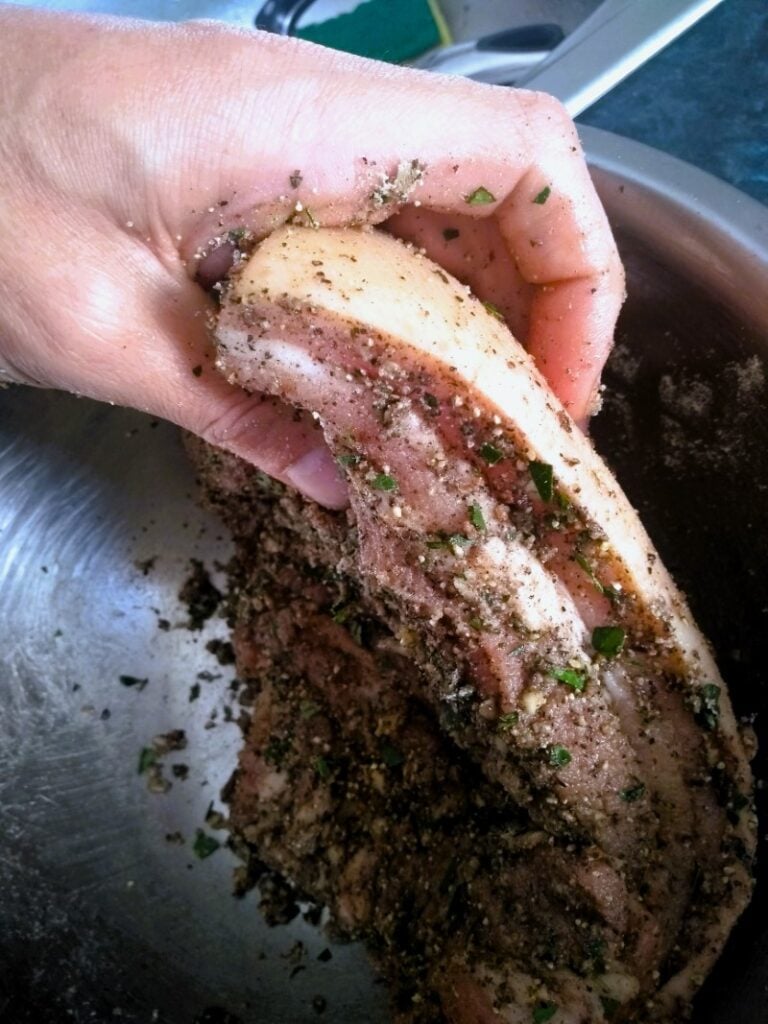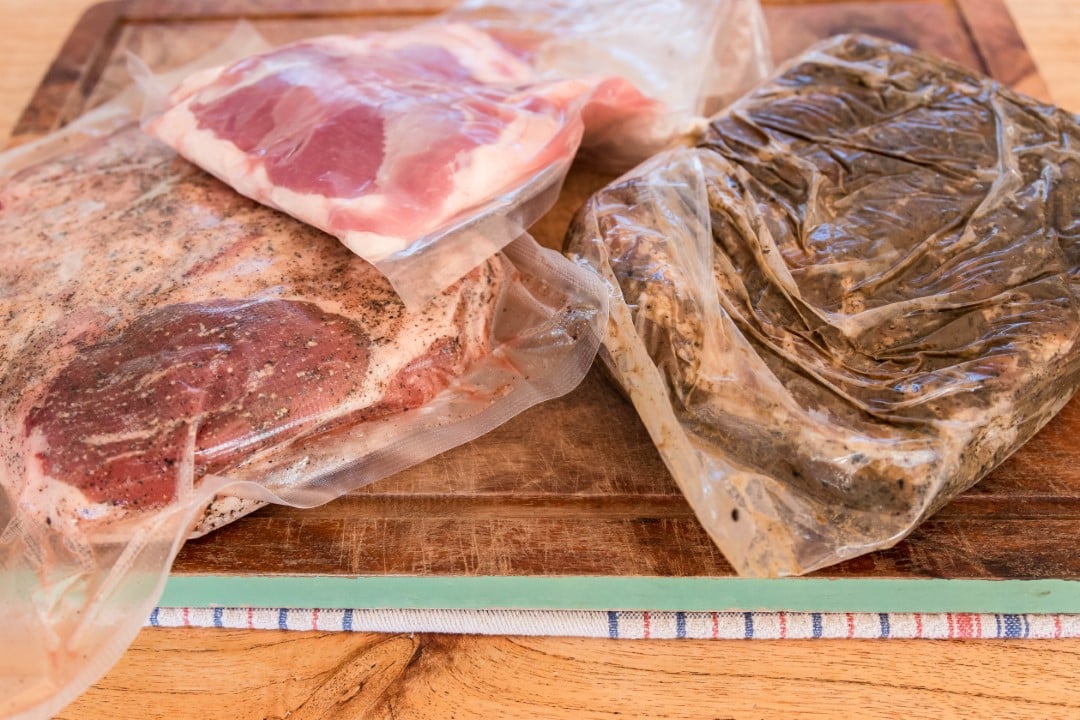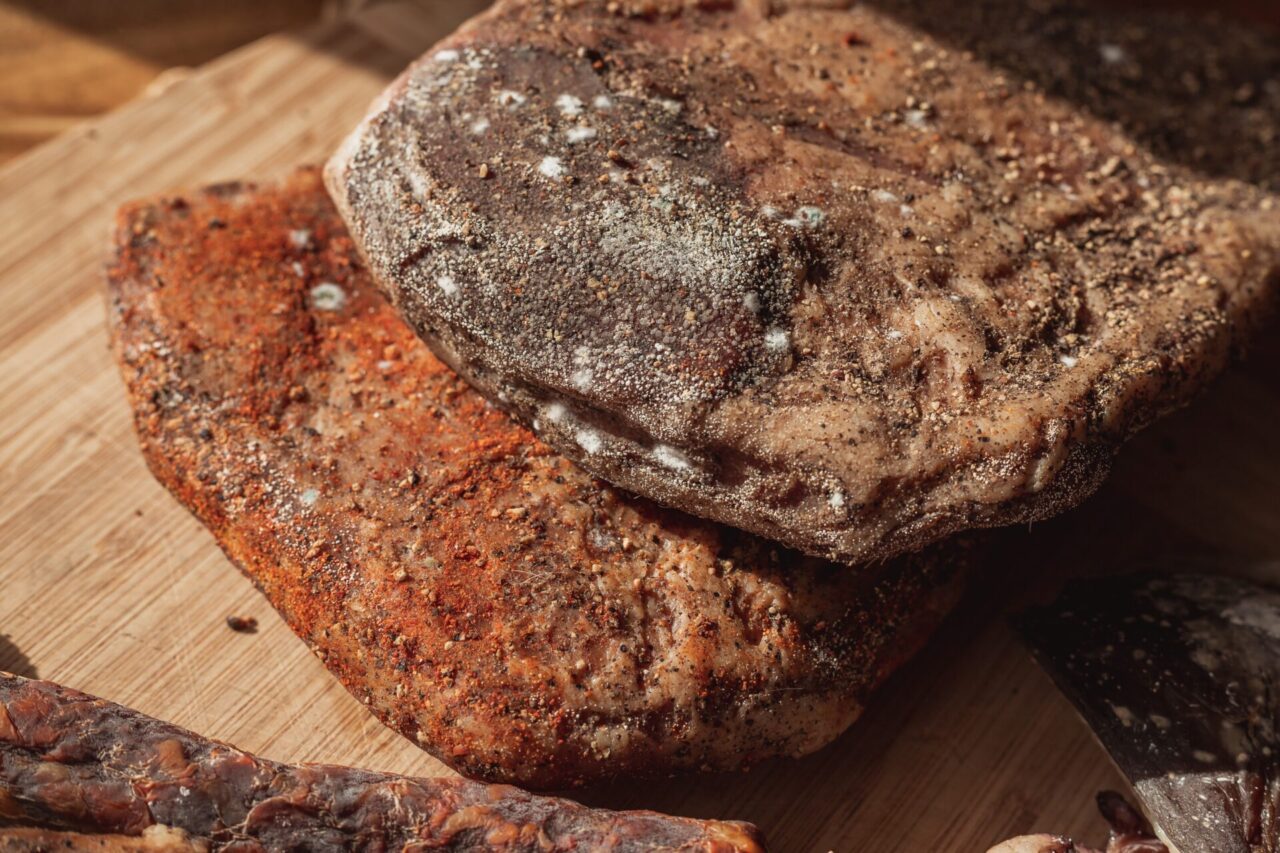Why Make Guanciale
Many Italians I’ve spoken to while living in Italy talk about Guanciale as some of the finest meat on a pig. Again, the pork quality is always a critical factor in dry-curing meat.
Versatility is the cornerstone of guanciale, much like pancetta. It represents a classic base flavor for many Italian dishes.
It is used for many of the most well-known Italian dishes (pasta, here is a solid Italian opinion on guanciale vs. pancetta for these dishes – Carbonara, Amatriciana and Gricia) or as an antipasti (charcuterie board appetizer). Similar to pancetta, it’s different; often, a well-aged pig marbles through the meat muscle of the jowl.

The fat is highly regarded from this part of the animal. If you want versatile, preserved, dry-cured meat on hand for appetizers or cooking, this is perfect for the above pasta classics.
I also believe that my quality guanciale is suitable as part of an antipasti or charcuterie board.
Key Ingredients
To make this recipe as helpful as possible, I’ve created a custom calculator inside the craft recipe below (or you can use the popular curing calculator page here, one to bookmark). This will auto-calculate the salt and spices based on the weight of the meat.
Sea Salt is essential for any curing project. For this style of equilibrium curing, it’s best to make the salt finer (I prefer powdery) and distribute it throughout the meat during curing.
If you use pink-curing salt in the recipe below, pink-curing salt no. 1 and no 2. are 90% salt.
Therefore, if you want a total salt amount of 2.25% for the cure
0.25% of this total can be the pink-curing salt.
Quality Jowl of the Pig
Quality jowl—the inside of the cheek is the ingredient; you need a reasonable fat ratio to meat.
When I break down a pig’s head (often a deal on these). The cheek and tongue I use for slow cooking since these are tough but nutritious. Personally, the brain is a bit creamy for me. The rest of the head creates a broths or terrine of
This often means the pig must be 12-14 months old. I’ve frequently found 24 months ideal for the meat-to-fat ratio (talk to the butcher or do the research!).
The process of dry curing meat intensifies the meat flavor, which is why meat quality is imperative to salt dry curing.
Sugar should not be an ingredient in classic Italian salumi of any kind.
Substitutes
Since this focuses on a traditional craft recipe with hundreds (possibly thousands) of years of history, it’s not appropriate to suggest substitutions.
However, if you need a similar style of dry-cured classic Italian meat, guanciale from the pig’s jowl is also used in Italy as a substitute. It has quality fat, and some would say it is the best fat on the pig.
Key Equipment
For this equilibrium salt dry curing method (link to a guide I wrote), an accurate digital scale – a subject covered a lot on this website, here is a page on scales. It’s nearly imperative (or another form of accurate scale allowing precise measurements of one decimal place per gram).
Having an adequate-sized bag for the jowl during curing is key. The air is to be removed inside the bag. I use Ziploc bags, or water bath/sous vide bags for this task. The goal is to have the meat and cure “equalizing” inside the bag.
How to make Guanciale
If need be, you trim and process the meat first. Then, the curing stage begins, which can take 1 to 2 weeks.
After curing, the drying and hanging stage applies until sufficient moisture loss and weight loss have occurred.
Curing Steps
Step 1
Depending on the jowl, you may need to shape and trim it. Remember, there are numerous glands in the muscle. I’ve often cut out 8-10 or more. I’ve probably sometimes left some in accidentally. There is a chance they carry unwanted bacteria, which may affect the outcome of the project.


Step 2
Weighing the jowl meat first for the equilibrium curing method, you can also record the minimum 25-30% weight loss needed for the drying process below. If the jowl is fat, weight loss will occur slower; if it is fat, it may never reach 35%, for instance. You’ll see the weight loss taper off in this instance.
If using nitrates/nitrites, accurately calculate the required pink-curing salt No. 2 (optional). No.2 Pink Curing is for meat-curing projects over 30 days long.
Step 3
Use a mortar and pestle or spice grinder to make the salt cure mixture finer; if it is coarse, this will help spread the mixture evenly across the jowl.

Ensure there are no lumps to spice clusters in the cure mixture.
Step 4
Mix salt cure mixture, and apply to meat in a bowl or lipped metal tray.

Step 5
Mix salt cure mixture, and apply to meat in a bowl or lipped metal tray. Place the meat and all the cure mixture from the bowl into a bag. Ideally flat, try and place all the cure mixture into the bag.
Step 6
Remove the air from the vacpac or ziplock bag, the goal is to have the minimal air in the bag during curing.

Step 7
Cure in a fridge or cool area at 2-6°C or 35-45°F
Imperial – 3 Days per Inch Thickness of Meat
Metric – 3 Days per 25mm Thickness of Meat
The advantage of using equilibrium curing, you can have the meat curing for an extra week or two. This will not increase the saltiness of the meat because it’s equalized the salt content throughout the meat.
Drying Steps
Step 8
Once fully cured, remove the bag & rinse, optional, with water or wine.
(If you forgot, weigh the meat and calculate % of the weight; this is a minimum weight loss for the finished product, after hanging/drying.)
Stage 9
Make holes carefully through one end of the jowl, ideally the thinner side. Use S hooks or butcher twine to create a hanging system.
Hang the cured jowl in a suitable environment. This could be a wine cellar, garage, shed, DIY dry curing chamber, commercial dry curing chamber, or other suitable environment
The conditions should be in this range approximately:
| Temperature | Humidity |
| 50-61°F/10-16°C | 65-80% |
You will need to check the meat regularly while it is drying. The reason for these conditions is to slowly dry the meat without drying the outside before the inside loses moisture (often called ‘case hardening’).
Airflow will also vary the speed of drying. A small amount of airflow is desirable, and ‘fresh’ air or a breeze is often preferred to avoid unwanted mold.
If too much ‘good’ mold forms, you can use vinegar to wipe or brush away the excess. For more on molds, please read this article.
Step 10
Once the weight loss is at least 30%, the dry-cured meat is finished and can be eaten as is or used for cooking!


Expert Tips
- For extremely high fat-to-meat ratios, weight loss can be lower than 30%. The pork’s fat contains less water, so it doesn’t lose as much weight as the meat muscle.
- Pork Fat salt curing can also take longer since this curing method (equilibrium curing) is flexible regarding the time in the curing stage. An extra week can ensure the cure is evenly distributed for very fatty pork cuts.
Recipe Variations
You can vary the amount of sea salt to your preference. A minimum of 2.0% salt is needed for curing. My personal salt level is often 2.25% total.
The maximum I prefer for saltiness in dry-cured whole muscle is 3.0%.
What & How to Serve
- Slice wafer-thin, add to antipasti board as a starter/appetizer
- Cut into cubes and making a classic Carbonara, Amatriciana or Gricia pasta dish.
- Guanciale is a base flavor for amazing broths, soups and to add a degree of umami to many dishes.
Frequently Asked Questions
-
Difference Between Guanciale and Salt Pork
Guanciale is the jowl muscle, and salt pork is often the pork belly. The amount of salt in salt pork is high. Often, it’s not like Guanciale, where the salt concentration is balanced, so it’s carefully dried for preservation. Salt pork is not eaten without cooking.
-
What to Do with the Rind/Skin of the Guanciale
Using the rind for flavoring soups or broths adds a depth of flavor.
-
Is Guanciale Made From the Pork Cheek?
No, it’s not the cheek, it’s underneath the cheek – the jowl it a different muscle.
-
Butchering a Pigs Head, What do I do with the cheek and tongue?
The cuts of meat are suited to long, slow cooking in liquid to tenderize.
Storing and Shelf Life
If the environment is cool, approximately 50-60°F/10-15°C, the guanciale can be hung around the kitchen. It’s preserved, so you can just cut amounts off as needed.
Placing it unwrapped in the fridge will speed up the drying. Most domestic fridges have a humidity of 20-40%.
Vacuum-packing and placing it in the fridge can be used to store it for several years. I’ve had dry-cured meats in vac-packed bags in my fridge for three years.
More Craft Recipes You’ll Enjoy
What to Expect for Serving Size
Since the guanciale has often lost 30% of its weight, it’s a more condensed form of protein. Dry-cured salumi, like guanciale, were never produced to be eaten as a main protein for a meal.
It’s a craft creation to be savored in small amounts. Twenty to fifty grams is plenty per person as a starter.
Scaling the Craft Recipe
You will see below the recipe has an auto-calculating recipe based on the input of the meat weight.
This will allow you to calculate the salt cure mixture.
Guanciale – Dry Cured (Equilibrium)
One of the most classic's from Italy, Guanciale is the salt dry cured jowl of a quality pig. Using quality pork from a well-fed, older animal jowl of the pig is used, boneless and often triangular in shape (could be 1-3kg / 2-6 lbs). One of the most versatile Italian's classic dry cured meats. It's used in many Italian dishes or can be served as a antipasti/charcuterie board.
Ingredients
- 1000 g Qualit Pig Jowl (Inside Cheek)
- 22.5 g Salt (2.25% of meat weight)
- 5 g Black Peppercorns (0.5% of meat weight)
- 2.5 g Pink Curing Salt No. 2 (Prague Powder #2, Instacure #2, many other names – To be used for over 30 days meat curing projects (0.25% of meat weight) Optional See Notes
Instructions
Curing Steps
-
Trim to the desired shape. Skin is left on. Carefully remove glands on meat.
-
Weigh the meat accurately, record weight
-
Calculate or Use the Recipe Above to Auto-calculate the Salt and Spices
-
Use a Mortar and Pestle or Spice Grinder to mix the salt and spices. Mix salt, spices, and optional curing agents thoroughly, ensuring even distribution in the cure.
-
In a large bowl or tray rub and cover the meat with the salt and spices (it will seem like not much, but this is enough of the cure)
-
Apply the Cure: Coat the meat with the curing mixture, ensuring all surfaces are covered, including crevices in the meat.
-
Place the meat and all the salt cure mixture into a sealable bag- options include vacuum bags, zip lock bags etc.
-
Remove From Bag
Hanging and Drying Steps
-
Optionally, apply additional spices or aromatics before hanging – ie. chili, peppercorns
-
Hang in a Suitable Environment. Often 50-60°F / 10-50°C. Humdity of 70-80% ideally. Make a hole with a knife for either a S hook or some butcher twine. Hang the meat in a cool, well-ventilated Area, Cellar, Garage, DIY Curing Chamber, Regular Fridge, Dry Curing Chamber
-
Monitor Progress: Regularly check the meat’s weight and appearance to gauge the curing process’s progression. Vinegar dabbed onto mold can remove it, if excessive growth occurs.
-
Achieve weight loss of a minimum 30%, ideally 35-40%. However, large fat amounts have less water in regards to Weight loss.
Recipe Notes
Please note that the craft of making dry-cured meats is beyond a recipe. This is not a cooked product. It takes a reasonable amount of knowledge to create salumi, charcuterie, and salami safely.
My advice is if you have doubts about smell or visual cues, then it’s not worth eating.
This is my interpretation of a classic salumi whole muscle dry cured meat project.
- Hang the meat in a suitable environment, ensuring proper airflow and humidity levels for optimal drying.
- For small amounts under 300 grams, you can dry the meat on a non-reactive rack in a regular fridge. However, the outcomes will be far from ideal.
- If fuzzy or powdery white mold develops, you must use your senses to assess it. Here is an article about mold in detail.
- Pink Curing salt is an optional ingredient – please carefully read this other article I’ve written about this.
- If you want to build a DIY dry chamber, I’ve written extensively on the topic here.
- Always complete the drying before consumption.
- Uneven drying is always an issue when making dry-cured meats after weight loss is complete. Removing the mold with vinegar, leaving it to dry in a regular fridge, and then vacuum packing for 4-8 weeks can equalize the meat moisture evenly.
Look forward to hearing about your thoughts and results! Leave a comment below.

Tom Mueller
For decades, immersed in studying, working, learning, and teaching the craft of meat curing, sharing the passion and showcasing the world of charcuterie and smoked meat. Read More




